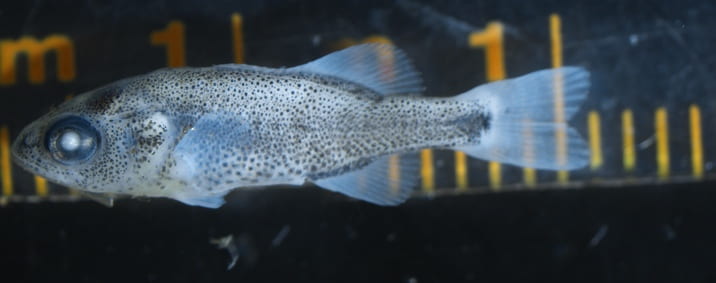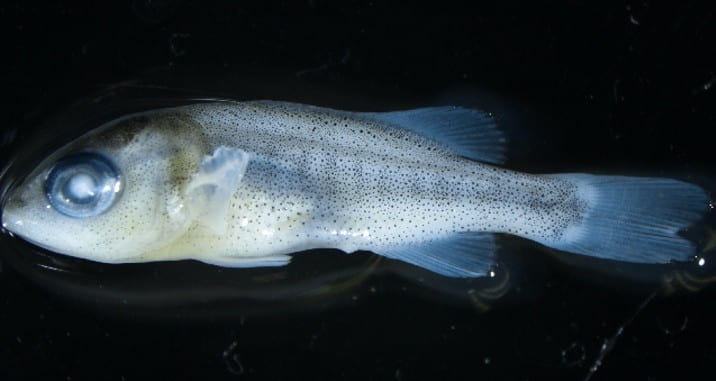Key Characteristics:
- Heavily pigmented
- Preanal myomeres: 13-16
- Postanal myomeres: 16-18
- Robust body, large head

Larval Smallmouth Bass. 16 mm. United States Fish Wildlife Service. Milwaukee Harbor, WI. Ashley Smith. 2018.

Larval Smallmouth Bass. 18 mm. United States Fish Wildlife Service. Milwaukee Harbor, WI. Adam Dziewa. 2018.

Larval Smallmouth Bass. 20 mm. United States Fish Wildlife Service. Milwaukee Harbor, WI. Adam Dziewa. 2018
- Body not elongated, eel-shaped, round in transverse section, uniformly pigmented (1B)
- Chin barbels absent (3B)
- Snout short, its length usually less than 10% TL; median fins otherwise (5B)
- Median fins or finfolds showing distinct separation (7B)
- No adipose fin, or demarcation of one, in finfold (10B)
- Preanal myomeres greater than or equal to postanal myomeres (14A)
- Preanal myomeres approximately equal to postanal myomeres (difference five myomeres or less) (15A)
- Total myomeres less than 35 (20B)
- Total myomeres between 26 and 34 (21B)
- Adipose fin or its position absent (23B)
- Double Dorsal Fin (24A)
- (Centrarchidae)
Adult History
- Physical Description
- Coloration of sides and back vary (dark green, pale gold, or brown), back of terminal mouth does not extend past the red eye, dark caudal spot by tail, dorsal fin consists of two lobes which are connected, dark or faint vertical bars, 69-80 lateral line scales, and 3 spines in anal fin while 9-11 spines in dorsal fin
- Spawning Habitat
- Streams, rivers and along the shores of lakes
- Protected by waves and wind o Nests are found between 3 – 10 feet
- Spawning Substrate
- Eggs are deposited on sand, gravel, and rocks.
- Spawning Behavior
- Polygynandry Behavior
- Males guard their small rounded nests or territories
- Males will also guard their eggs and young until fry disperse
- Multiple females can deposit their eggs in either multiple or one males’ nests
- Polygynandry Behavior
- Courtship Behaviors
- When a female enters the male’s territory, a dance occurs were they begin to bite and rub with one another
- Female is chased off to another male’s nest when she deposits her eggs
- Time of Year
- April – May/June in Lake Michigan
- Spawning typically takes place at water temperatures of 53 – 75°F
- Diet
- Carnivore & Planktivore
- Small fish, crayfish, insects, frogs (other amphibians), aquatic crustaceans, zooplankton, and phytoplankton

